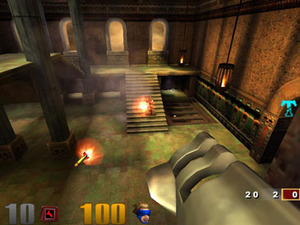
The state of modern games and their implications
Post 1997, the modern era, there are too many games that critics have targeted to list. Graphical improvements across the board have made it more and more difficult to provide the ‘shock’ factor and so developers have had to go further in order to achieve notoriety.Grand Theft Auto III placed you inside a city that felt alive and allowed the gamer to run rampant killing, maiming and destroying anything in sight –now the concept of free roaming destruction round a city is standard for most action/adventure games. First Person Shooters such as Far Cry, Half Life 2 and F.E.A.R involve incredibly detailed gore filled images and although not photo-realistic yet, the games of the next decade will be extremely close to achieving that level of realism. It is hardly surprising that military units around the world are now using ‘games’ to help train their soldiers before sending them to combat.
The fact that our troops may be using games to prepare for combat is not something that will cause concern amongst the majority. But what if a very different type of army starts to use the medium of video games as a way to ‘train’ their soldiers? Last year, radical racist producers Resistance Records developed a video game in which the object was to kill ethnic minorities. The game promotes all kinds of racism and is aimed at children, allowing them to play as the Ku-Klux-Klan whilst wondering round cities looking for people to string up. To complete the game the player must destroy Israeli leader Ariel Sharon.
Ethnic Cleansing is only the first in a series of games the producers plan to release. Where is the line drawn between inciting people to carry out acts of virtual mindless violence in Grand Theft Auto and inciting them to carry out acts of virtual mindless violence against minorities? Perhaps the only saving grace GTA has going for it is that it is at least indiscriminatly hostile!
However the realism of games, and its use as a messaging tool is only one area that has raised concerns. More and more games look to exploit sex as a selling point, such as Leisure Suit Larry, Lula, and even mainstream games like BloodRayne and Tomb Raider to some degree.
Whilst we live in something of a global internet age, attitudes and laws on expression and freedom vary massively from country to country. How video games permeate culture, then, also varies massively.


The blood-splattered F.E.A.R., left, and the latest Lara Croft Tomb Raider model, Karima Adibebe, right.
How Different Countries Deal with Controversial Games
As has already been mentioned, the first company to 'censor' games was Nintendo with its Seal of Approval. It would be foolish to think that Nintendo’s new policy was to protect the innocence of children worldwide, as the move was with the intent of surviving the market crash of 1983. The new Nintendo system was marketed as family friendly and parents up and down the United States and Europe lapped up the new layer of protection the Japanese company offered.Now games that are purchased in shops are often classified according to the age range they are deemed suitable for. There are a few bodies who perform these classifications and they differ from country to country but the most influential at this present time are the British Board of Film Classification, Entertainment Software Rating Board and Pan European Gaming Information Board. In the most part their ratings are split up into four age brackets: ages 3, 12, 15 and 18, in a similar way to movie ratings.
In the UK, games are rated voluntarily by ELSPA and you will find that all games carry a recommended rating. This rating is not compulsory or legally binding. However, in England, the BBFC has the power to also enforce a legal rating on a game which carries the same weight as a rating on a video or DVD, making it illegal to sell to someone under the age.
In the US, games are voluntarily rated by the ESRB. Unlike in Britain, there is no way to legally restrict the sale of a game to a certain age group, since the rating is not legally binding. In the UK and America banning a game is nigh-on impossible, with freedoms to play prevalent.
This is not necessarily the case elsewhere. The Greek government banned the playing of computer games in public in 2002. The law was designed to combat online gambling, but had the effect that two LAN café owners were dragged into court for allowing people to play the team shooter Counter-Strike. The government has since changed the law after pressure from the EU, but there still remains a ban on video games at all LAN cafes. As recently as 2004, 80 computers were taken from a café in a raid by Greek police.
There are a whole host of countries with reservations about games - check out this fairly comprehensive list at Wikipedia. Most notably the Quake series has been banned in Germany, a multiplayer hotspot. Command and Conquer: Generals was banned in China as the government would not stand for the idea of terrorists attacking the Chinese people. Pokemon Blue was banned in Saudi Arabia for its Jewish undertones whilst Postal and its sequel, Postal 2 would have shorter lists if I just wrote down the countries that didn’t ban them.
Also notable is Australia, which does not have a category of video games equivalent to the 18+ rating in the US or the UK. Any game with content that lays outside the 15-rating - such as GTA - is uniformly banned from sale.


Quake I, Quake II and Quake III Arena (left) banned in Germany. Command & Conquer: Generals (right) was banned in China

MSI MPG Velox 100R Chassis Review
October 14 2021 | 15:04









Want to comment? Please log in.